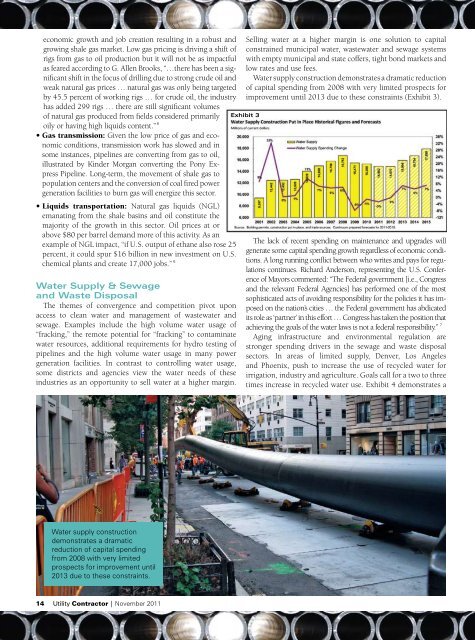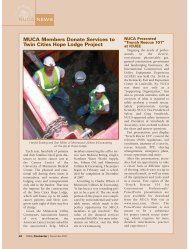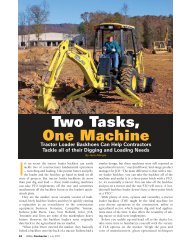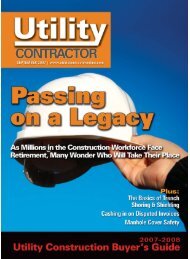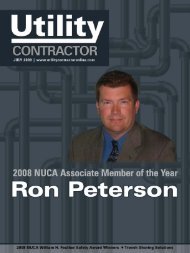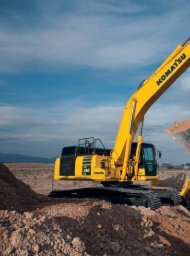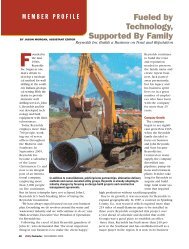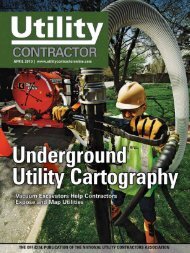View Full November PDF Issue - Utility Contractor Magazine
View Full November PDF Issue - Utility Contractor Magazine
View Full November PDF Issue - Utility Contractor Magazine
You also want an ePaper? Increase the reach of your titles
YUMPU automatically turns print PDFs into web optimized ePapers that Google loves.
economic growth and job creation resulting in a robust and<br />
growing shale gas market. Low gas pricing is driving a shift of<br />
rigs from gas to oil production but it will not be as impactful<br />
as feared according to G. Allen Brooks, “…there has been a significant<br />
shift in the focus of drilling due to strong crude oil and<br />
weak natural gas prices … natural gas was only being targeted<br />
by 45.5 percent of working rigs … for crude oil, the industry<br />
has added 299 rigs … there are still significant volumes<br />
of natural gas produced from fields considered primarily<br />
oily or having high liquids content.” 6<br />
• Gas transmission: Given the low price of gas and economic<br />
conditions, transmission work has slowed and in<br />
some instances, pipelines are converting from gas to oil,<br />
illustrated by Kinder Morgan converting the Pony Express<br />
Pipeline. Long-term, the movement of shale gas to<br />
population centers and the conversion of coal fired power<br />
generation facilities to burn gas will energize this sector.<br />
• Liquids transportation: Natural gas liquids (NGL)<br />
emanating from the shale basins and oil constitute the<br />
majority of the growth in this sector. Oil prices at or<br />
above $80 per barrel demand more of this activity. As an<br />
example of NGL impact, “if U.S. output of ethane also rose 25<br />
percent, it could spur $16 billion in new investment on U.S.<br />
chemical plants and create 17,000 jobs.” 6<br />
Water Supply & Sewage<br />
and Waste Disposal<br />
The themes of convergence and competition pivot upon<br />
access to clean water and management of wastewater and<br />
sewage. Examples include the high volume water usage of<br />
“fracking,” the remote potential for “fracking” to contaminate<br />
water resources, additional requirements for hydro testing of<br />
pipelines and the high volume water usage in many power<br />
generation facilities. In contrast to controlling water usage,<br />
some districts and agencies view the water needs of these<br />
industries as an opportunity to sell water at a higher margin.<br />
Selling water at a higher margin is one solution to capital<br />
constrained municipal water, wastewater and sewage systems<br />
with empty municipal and state coffers, tight bond markets and<br />
low rates and use fees.<br />
Water supply construction demonstrates a dramatic reduction<br />
of capital spending from 2008 with very limited prospects for<br />
improvement until 2013 due to these constraints (Exhibit 3).<br />
Exhibit 3<br />
The lack of recent spending on maintenance and upgrades will<br />
generate some capital spending growth regardless of economic conditions.<br />
A long running conflict between who writes and pays for regulations<br />
continues. Richard Anderson, representing the U.S. Conference<br />
of Mayors commented: “The Federal government [i.e., Congress<br />
and the relevant Federal Agencies] has performed one of the most<br />
sophisticated acts of avoiding responsibility for the policies it has imposed<br />
on the nation’s cities … the Federal government has abdicated<br />
its role as ‘partner’ in this effort … Congress has taken the position that<br />
achieving the goals of the water laws is not a federal responsibility.” 7<br />
Aging infrastructure and environmental regulation are<br />
stronger spending drivers in the sewage and waste disposal<br />
sectors. In areas of limited supply, Denver, Los Angeles<br />
and Phoenix, push to increase the use of recycled water for<br />
irrigation, industry and agriculture. Goals call for a two to three<br />
times increase in recycled water use. Exhibit 4 demonstrates a<br />
Water supply construction<br />
demonstrates a dramatic<br />
reduction of capital spending<br />
from 2008 with very limited<br />
prospects for improvement until<br />
2013 due to these constraints.<br />
14 <strong>Utility</strong> <strong>Contractor</strong> | <strong>November</strong> 2011


